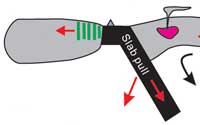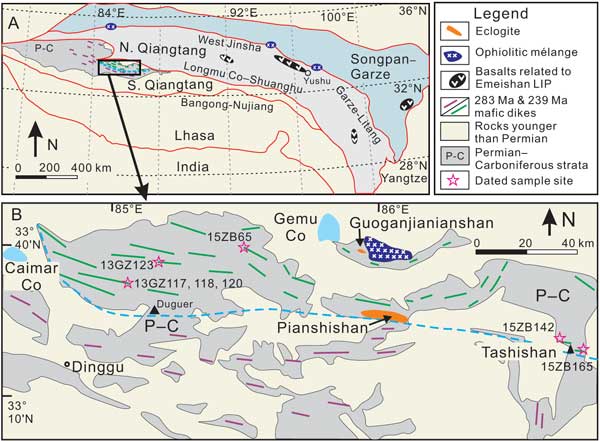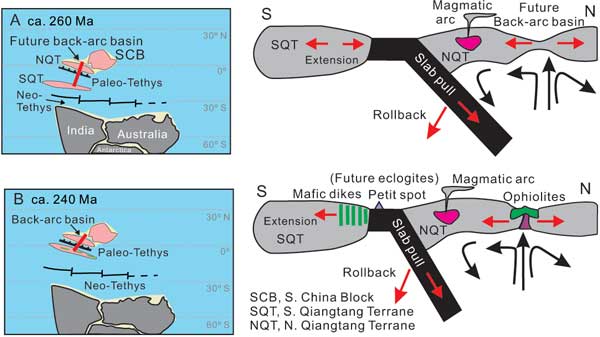 |
Passive margin magmatism caused by enhanced slab pull forces |
Wei Dan1,2, Qiang Wang1,2, William M. White3, Xian-Hua Li4, Xiu-Zheng Zhang1,2, Gong-Jian Tang1,2
1State Key Laboratory of Isotope Geochemistry, Guangzhou Institute of Geochemistry, Chinese Academy of Sciences, Guangzhou 510640, China; danwei@gig.ac.cn ; wqiang@gig.ac.cn ; zhangxz@gig.ac.cn ; tanggj@gia.c.cn
2CAS Center for Excellence in Deep Earth Science, Guangzhou 510640, China
3Department of Earth and Atmospheric Sciences, Cornell University, Ithaca, New York 14853, USA; wmw4@cornell.edu
4State Key Laboratory of Lithospheric Evolution, Institute of Geology and Geophysics, Chinese Academy of Sciences, Beijing 100029, China; lixh@gig.ac.cn
This webpage is a summary of: Dan W., Wang Q., White W.M., Li X.H., Zhang X.Z., Tang G.J., Ou Q., Hao L.L., Qi Y., 2021. Passive-margin magmatism caused by enhanced slab-pull forces in central Tibet. Geology 49, 130-134.
Introduction
Most magmatism on Earth is directly related to plate tectonics, occurring either at divergent plate boundaries or on the overriding plate in subduction zones. Intraplate magmatism is, by comparison, less common, and enigmatic. Its origin, i.e., mantle plume vs. plate tectonics, is hotly debated. During the past few years, some intraplate magmatism on overriding plates has been explained as related to oceanic slabs subducted into the mantle transition zone. However, there is no consensus on the generation of intraplate magmatism on the lower plates, especially in continental settings. Passive margins, generally thought to be tectonically inactive and non-magmatic, are a special, lower-plate intraplate setting. Slab pull forces resulting from oceanic slab subduction are important driving forces of plate motion, and can cause pronounced extension in the lower plate, especially during or after subduction of a mid-ocean ridge (Gutiérrez-Alonso et al., 2008; Belguith et al., 2013) when the subducting slab becomes geodynamically coupled to a passive margin on the opposite side of the ocean. Lower-plate passive margin magmatism has been rarely documented, which hinders understanding of how slab pull may induce it.
Observations
Here we report on a Middle Triassic mafic dike swarm that intruded into the passive margin of central Tibet when a Paleo-Tethys oceanic slab subducted beneath Eurasia. The Central Tibetan Plateau consists of Songpan-Garze, Northern Qiangtang, and Southern Qiangtang terranes with intervening sutures (Figure 1a). The Longmu Co-Shuanghu suture between the Northern and Southern Qiangtang terranes preserves a segment of the Paleo-Tethys Ocean. The western and southwestern parts of the Songpan-Garze terrane located to the north probably formed as a Late Permian-Middle Triassic back-arc basin related to rollback of the Paleo-Tethys oceanic slab to the south (Liu et al., 2016; Wang et al., 2018). The northern margin of the Southern Qiangtang terrane was a passive margin as the Paleo-Tethys Ocean subducted beneath Eurasia until it collided with the Northern Qiangtang terrane at ~233 Ma (Dan et al., 2018).
In expeditions in 2013 and 2015 we discovered mafic dikes, named the Duguer dikes, which outcrop over 4,000 km2 in the northern part of the Southern Qiangtang (Figure 1b) (Dan et al., 2021). The Duguer dikes were emplaced at ~239 Ma, ~44 million years after the major ~283 Ma Qiangtang dikes (part of a large igneous province) but before ocean closure at ~233 Ma (Dan et al., 2018). Thus, the ~239 Ma Duguer magmatism occurred on a passive margin on the lower plate undergoing subduction prior to closure of the Paleo-Tethys Ocean.

Figure 1: Simplified geological map of the Qiangtang mafic dikes in Tibet. Dashed blue line in B separates ca. 239 Ma (green) from ca. 283 Ma (purple) mafic dike swarms. Click here or on Figure for enlargement.
This newly discovered intraplate magmatism cannot be easily explained by previous models. The ~239 Ma Duguer dikes outcrop over a small area and have normal mantle potential temperatures (1336-1414°C), in contrast to melts of mantle plumes which typically have much higher potential temperatures. They also lack evidence of the time-transgressive magmatism that is a key characteristic of plume-related volcanism. The Southern Qiangtang terrane is characterized by thin lithosphere that favors neither delamination nor edge-driven convection. Previous studies have suggested that magmatism in passive margins can occur following ocean ridge subduction, which may allow slab pull forces to be transmitted to passive margins on the opposite side of ocean basins (Gutiérrez-Alonso et al., 2008). However, the Paleo-Tethys ocean ridge is thought to have been subducted during the Late Carboniferous-earliest Permian (Gutiérrez-Alonso et al., 2008), about 60 Myr before the 239 Ma magmatism.
A new model
We propose a new model in which enhanced slab pull forces explain the ~239 Ma passive margin magmatism (Figure 2). Geodynamic modeling shows that ~75-80% of slab pull forces associated with subduction are propagated through the bend in the subducting slab (Capitanio et al., 2009), indicating that significant extension and magmatism can be induced along passive margins long after ocean ridge subduction (Bellahsen et al., 2003). It has recently been demonstrated that rollback of the Paleo-Tethys oceanic slab produced the Garze-Litang back-arc basin to the north during the Late Permian-Middle Triassic (Liu et al., 2016; Wang et al., 2018). During slab rollback, slab pull forces are redistributed and increased (Wortel & Spakman, 2000) and can cause significant lithospheric extension (up to 25% extension) in the margin of the lower plate (Bellahsen et al., 2003). The strain of enhanced slab pull forces could have been transmitted as far-field stresses to the passive margin and focused along a pre-existing weak zone of continental lithosphere (Bellahsen et al., 2003). This could result in the lithospheric extension that produced the ~239 Ma magmatism. This extension also produced minor coeval “petit-spot” volcanism (Hirano et al., 2006) on the adjacent stronger, oceanic lithosphere (Dan et al., 2018).

Figure 2: Schematic illustrations of central Tibet evolution during the Middle Permian-Triassic. (a) the Paleo-Tethys oceanic slab underwent rollback beginning at ~260 Ma, long after the ocean ridge subduction causing initial extension both in the upper and lower plates; (b) significant extension at ~239 Ma generated a back-arc basin in the upper plate, and magmatism in the lower plate, including massive mafic dikes in the passive margin and petit-spots in the remnant ocean with width likely < 200 km (Dan et al., 2018). Red lines in the left panels indicate schematic cross section in corresponding right panels. Click here or on Figure for enlargement.
A likely Cenozoic analogue is found in the Sicily channel rift zone, eastern Mediterranean, where intraplate magmatism in the lower plate was concomitant with a back-arc basin that formed in the upper plate with a ~400 km wide ocean (Argnani, 1990; Belguith et al., 2013). This Cenozoic example occurred in the margin of a large plate, whereas the Tibetan example occurred in a microcontinent. These examples indicate that although enhanced slab pull may persist for tens of Myr causing extension in a long-evolved passive margin, the associated magmatism occurs over a relatively brief interval. They also indicate that the model can be applied to remnant narrow oceans, which typically have a dense/old subducted slab that persists long after ocean ridge subduction, thereby facilitating rapid slab rollback (Schellart et al., 2007) and accompanying enhanced slab pull. The rarity of examples of such magmatism may be partly because such margins are likely to be subducted during subsequent orogenesis. If so, evidence of associated magmatism may be preserved in some eclogitic complexes in subduction channels. Alternatively, these rocks may have been misinterpreted as subduction-related magmatism. Future studies may reveal more examples of such lower plate magmatism.
Summary
We document an example of intraplate magmatism in the lower plate caused by regional extension, rather than a mantle plume or local mantle geodynamics. In the aftermath of ocean ridge subduction, enhanced slab pull forces associated with rollback of the subducting slab induced the opening of a back-arc basin on the upper plate and coeval magmatism in the passive margin of the lower plate, on the margin opposite to the subduction. Our analysis suggests that intraplate magmatism can be induced on the lower plate by enhanced slab pull forces associated with subduction.
References
-
Argnani, A., 1990. The Strait of Sicily Rift-Zone - Foreland Deformation Related to the Evolution of a Back-Arc Basin. Journal of Geodynamics 12, 311-331.
-
Belguith, Y., Geoffroy, L., Mourgues, R., Rigane, A., 2013. Analogue modelling of Late Miocene–Early Quaternary continental crustal extension in the Tunisia–Sicily Channel area. Tectonophysics 608, 576-585.
-
Bellahsen, N., Faccenna, C., Funiciello, F., Daniel, J.M., Jolivet, L., 2003. Why did Arabia separate from Africa? Insights from 3-D laboratory experiments. Earth and Planetary Science Letters 216, 365-381.
-
Capitanio, F.A., Morra, G., Goes, S., 2009. Dynamics of plate bending at the trench and slab-plate coupling: Geochemistry Geophysics Geosystems 10, Q04002, https://doi .org/10.1029/2008GC002348.
-
Dan, W., Wang, Q., White, W.M., Zhang, X.Z., Tang, G.J., Jiang, Z.Q., Hao, L.L., Ou, Q., 2018. Rapid formation of eclogites during a nearly closed ocean: Revisiting the Pianshishan eclogite in Qiangtang, central Tibetan Plateau. Chemical Geology 477, 112-122.
-
Dan W., Wang Q., White W.M., Li X.H., Zhang X.Z., Tang G.J., Ou Q., Hao L.L., Qi Y., 2021. Passive-margin magmatism caused by enhanced slab-pull forces in central Tibet. Geology 49, 130-134.
-
Gutiérrez-Alonso, G., Fernández-Suárez, J., Weil, A.B., Murphy, J.B., Nance, R.D., Corfu, F., Johnston, S.T., 2008. Self-subduction of the Pangaean global plate. Nature Geoscience 1, 549-553.
-
Hirano, N., Takahashi, E., Yamamoto, J., Abe, N., Ingle, S.P., Kaneoka, I., Hirata, T., Kimura, J.I., Ishii, T., Ogawa, Y., Machida, S., Suyehiro, K., 2006. Volcanism in response to plate flexure. Science 313, 1426-1428.
-
Liu, B., Ma, C.Q., Guo, Y.H., Xiong, F.H., Guo, P., Zhang, X., 2016. Petrogenesis and tectonic implications of Triassic mafic complexes with MORB/OIB affinities from the western Garze-Litang ophiolitic melange, central Tibetan Plateau. Lithos 260, 253-267.
-
Schellart, W.P., Freeman, J., Stegman, D.R., Moresi, L., May, D., 2007. Evolution and diversity of subduction zones controlled by slab width. Nature 446, 308–311.
-
Wang, J., Wang, Q., Zhang, C.F., Dan, W., Qi, Y., Zhang, X.Z., Xia, X.P., 2018. Late Permian Bimodal Volcanic Rocks in the Northern Qiangtang Terrane, Central Tibet: Evidence for Interaction Between the Emeishan Plume and the Paleo-Tethyan Subduction System. Journal of Geophysical Research-Solid Earth 123, 6540-6561.
-
Wortel, M.J.R., Spakman, W., 2000. Geophysics - Subduction and slab detachment in the Mediterranean-Carpathian region. Science 290, 1910-1917.
last updated 25th March, 2021 |
